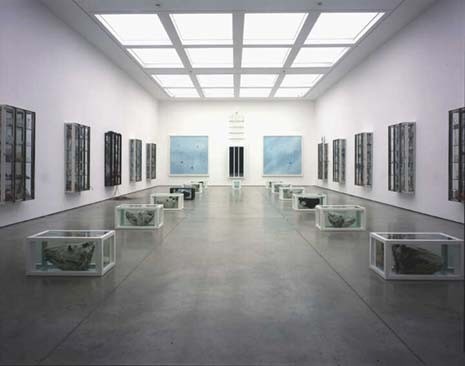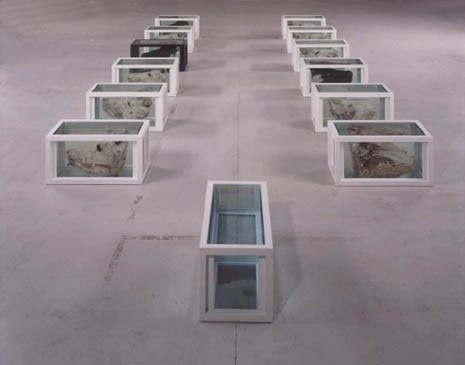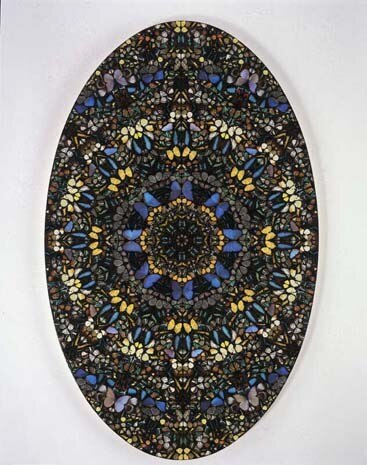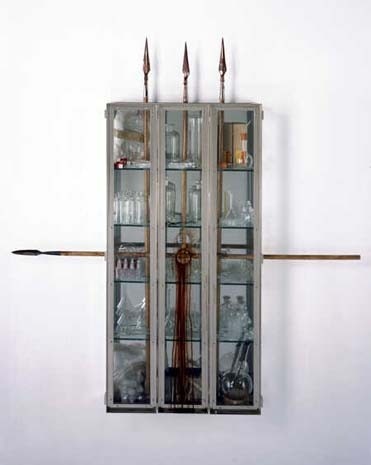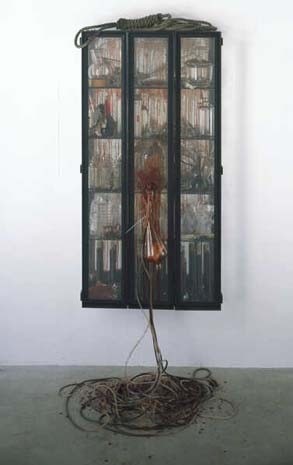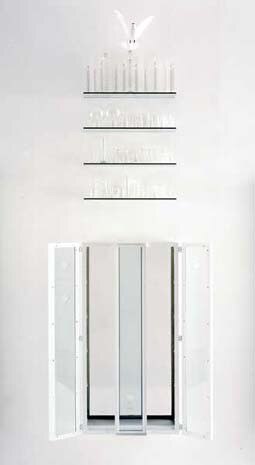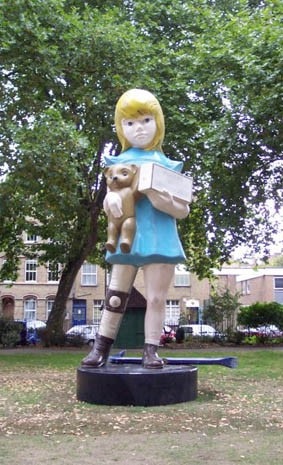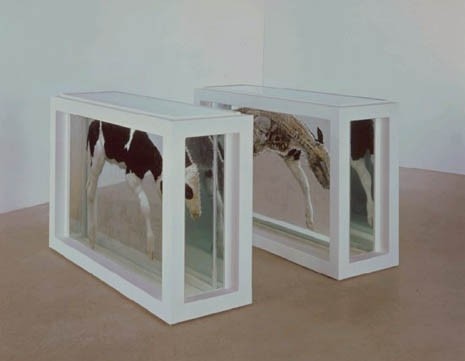Access to the gallery is almost blocked by a huge sculpture. It is “Prodigal Son”, a piece from 1994 that consists of a glass cabinet filled with formaldehyde in which is immersed a calf.
And so begins the journey through Damien Hirst’s one man show at the White Cube gallery in London, the first exhibition after an eight year absence from the city that was the launch pad for his planetary fame. After all that waiting, the first thing one comes across is a piece made almost ten years ago. It cannot be a random choice but should be read rather as a declaration of intent.
Hirst persists with the themes that have made him famous: life and death, and all the suffering and joy, horror and beauty that fill this temporal lapse. This has not been liked by certain critics who have seen their expectations of something new disregarded. They have been unable to read the obsessiveness of the artist as a positive factor, but most of all they have not realised that this exhibition, despite setting itself in direct connection with past research – as is announced with the piece which opens it – also indicates a shift in the practice of Damien Hirst, a change in the approach to his obsessions. It realises, that is, a passage from the rational to the irrational.
Having moved past the calf in formaldehyde, one finds oneself in the main room of the gallery – a white rectangle lit by a large skylight – transformed by Hirst into the nave of a church. Along the sides are twelve shrines – six on each side – in glass and metal, dedicated to the death of the Apostles: practically all made into martyrs except for Judas Iscariot, whose end we all know about. In the cabinets abound objects of various kinds: old medical glasswares, tubes of plastic, roles of sticky tape and rudimentary arms that refer to the way each apostle met his death.
The showcase dedicated to St Thomas is for example pierced with lances. On all of them is an abundance of blood – real, from reindeers according to the gallery staff – coagulated and evil smelling. The strong smell, nauseating at times, deliberately influences one’s perception of this exhibition which is first and foremost a physical and emotional experience. The violent impression is increased by the cow heads, also in formaldehyde, placed on the floor in an orderly fashion, opposite the showcases of the Apostles, representing the Disciples.
Looking down towards the end of the room, to the place where if we were really in a church we would find the altar, we see the container that symbolises Christ: it is the same size as those which hold the cow heads but is filled only with the preserving substance. Behind this, directly on the wall, is hung a small glass case with its doors open, its transparent glass shelves on which are placed the same number of medical containers have been transferred above the case itself and above them in turn is an embalmed dove. A clear enough allegory to the ascension of Jesus Christ and the only moment of relief – together with four beautiful paintings made with butterfly wings arranged in such a way as to form kaleidoscopic compositions which recall the polychromatic windows of churches, entitled “Pray”, “Rapture”, “Hope” and “Devotion” – in an installation that Hirst wanted to be symmetrical but redundant. Highly symbolic. Decidedly baroque. A dense, oppressive space, that directly hits the “nervous system” according to the lesson of Francis Bacon that Hirst seems to take much into account.
An artist who has certainly always aimed at the sensational, making it his real signature, this time an over the top, “dirty”, emotional signature has taken over, that marks the passage, mentioned previously from rationality to irrationality, from science to religion. Damien Hirst has said many times that he thinks about death every day of his life. And it is without a doubt that it is exactly this obsession that informs his artistic practice. And until this exhibition, medicine, as a metaphor of the attempt to transcend death, has been his field of exploration and favourite inspiration. From here the animals in formaldehyde and a whole series of installations and rigorous painting on which flutters more a sense of “suspended mortality” than immortality, which is what today science can in fact guarantee us. A limit that Hirst now seeks to overcome, appealing to irrationality, to its maximum expression that is religion. The artist – who received a Catholic education but today declares himself atheist – prefers to call it “Romance” even though it is actually religion, with its iconography and its notions, that breaks into his most recent production to coexist with science.
On the upper floor of the gallery the exhibition continues in a decidedly smaller room where various pieces have been set up, also of varying quality, that do not manage to enter in a reciprocal relationship as is instead the case in the display on the ground floor where old and new pieces form a homogeneous installation. Worth a mention however are three works: one, entitled “Memories lost. Fragments of Paradise”, is an “abbreviated” version of the glass case with medicine pills presented at the latest Venice Biennale: here the dimensions are reduced and the pills are all white instead of multicoloured.
Opposite are hung two canvases with little white balls (completely resembling pills) on a white background, with the allusive titles “Forgive” and “Forget”. Chemistry, applied to medicine helps us to forget (also our mortality), to forgive, to soothe physical and psychological suffering, bringing about a state of apparent serenity, where our vulnerability is reduced but still does not guarantee immortality. Religion, at least that of the spirit, has always promised it. But the price to pay is suffering itself, as the martyred saints remind us.
So where does Hirst stand? Probably “in the middle” in that symbolic area, situated in the garden adjacent to the gallery, where the artist has placed the enormous sculpture “Charity”, an enlarged charity collecting box, with the moving features of a crippled child, that has been forced open and emptied of its contents, with a pigs foot left at her feet as a witness. A metaphor of the cynicism of the human being, the scarcity of values in what Hirst calls, in the title of the exhibition, the “Age of Uncertainty”. The child’s expression, together with that of the artist, is directed towards the gallery where an attempt is taking place to join faith and science, emotionality and rationality. Certainly today Damien Hirst’s metaphors are less intriguing from an intellectual point of view because they don’t have areas of shade, do not leave space for questioning their meaning but opt rather for a high level of communicability which is equally visceral.
To say that this is a defect however, or a regression, would seem impolite.
until 19.10.2003
Damien Hirst Romance in the Age of Uncertainty
c/o White Cube
Hoxton Square 48, London N1 6PB
http://www.whitecube.com
